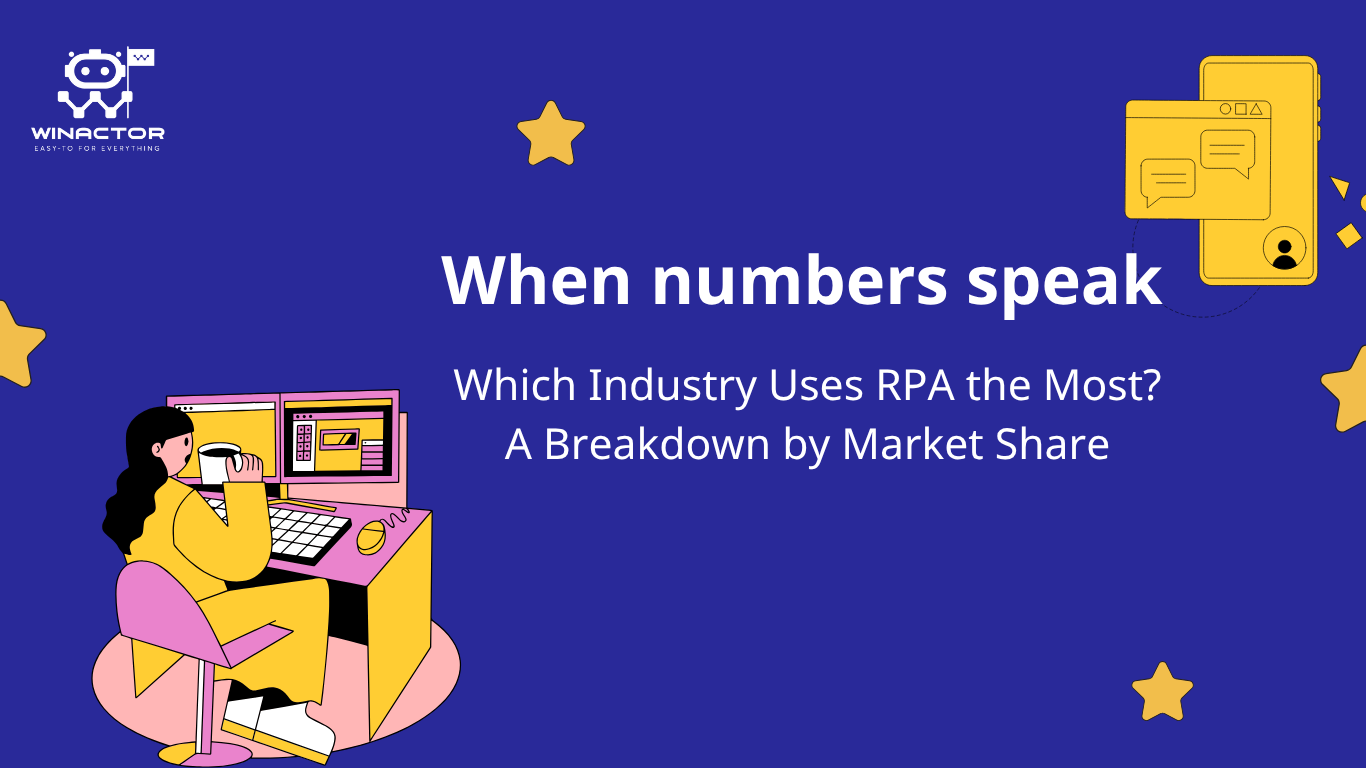For C-level leaders navigating digital transformation, Robotic Process Automation (RPA) is more than just a tool; it’s a strategic lever. Yet, the key to unlocking its full potential lies in knowing where it fits best.
In this article, we reveal the top 5 industries leading in RPA adoption, based on global market share, and show how real-world companies are using automation to create a measurable business impact. Whether you’re running a bank or scaling an online business, you’ll see why RPA is helping these sectors lead and how your organization can do the same.
Top 1. Banking & Financial Services – 29% of Global RPA Market
Market share: 29% of global RPA spend, according to Market Growth Reports
Why it’s ideal:
- Handles massive volumes of structured transactions daily
- Involves rule-based workflows under tight regulatory oversight
RPA use cases:
- Customer onboarding (e.g., KYC checks, document validation)
- Loan processing (credit scoring, document review)
- Regulatory reporting (automated compliance filings)
- Fraud detection (pattern monitoring, alerts)
RPA in action:
- JP Morgan Chase accelerates onboarding via KYC bots – cutting days to hours.
- Deutsche Bank automates compliance reporting, improving accuracy.
Payoff: RPA slashes operational costs by up to 30% and boosts customer experience.
Top 2. Insurance – 20% of Global RPA Market
Market share: ~20%, according to Market Growth Reports
Why it’s ideal:
- Manages massive document workflows – claims, policies, underwriting
- Common tasks are highly repetitive and rule-driven
RPA use cases:
- Claims processing (auto-validating data, initiating payouts)
- Policy servicing (renewals, endorsements, cancellations)
- Underwriting (data extraction for risk scoring)
- Compliance reporting (auditing, policy consistency)
RPA in action:
- Allianz uses bots to auto-approve routine claims.
- AXA automates policy servicing and customer notifications.
Payoff: Achieves 75% faster claim resolution, reduced errors, and better customer retention.
Top 3. Healthcare – 10–12% (Rapidly Growing)
Market share: 10–12% and climbing, according to Allied Market Research
Why it’s ideal:
- Staff face high admin burdens – EHR updates, billing, eligibility checks
- Compliance (HIPAA, coding) demands precision
RPA use cases:
- Insurance eligibility checks and appointment scheduling
- Billing and coding for insurance claims
- EHR updates and patient record entry
- Audit preparation for compliance bodies (HIPAA, ICD-10)
RPA in action:
- Cleveland Clinic automates insurance verification and appointment reminders.
- Mount Sinai uses bots for accurate EHR data entry.
Payoff: Up to 40% reduction in admin workload, letting clinicians focus on care.
Top 4. Retail & E-Commerce – 8–10% of RPA Market
Market share: 8–10%, according to Grand View Research
Why it’s ideal:
- Requires real-time transaction management across channels
- Manual processes still bog operations – inventory, fulfillment, returns
RPA use cases:
- Order processing (auto-invoicing, shipment tracking)
- Inventory updates across platforms in real time
- Returns & refunds (validations and crediting)
- Customer service (integrated with chatbots and CRMs)
RPA in action:
- Amazon syncs inventory and pricing globally with bots.
- Walmart automates order handling and back-office reconciliation.
Payoff: Up to 80% faster order processing, improved omnichannel efficiency.
Top 5. Telecommunications – 5–6% of RPA Market
Market share: 5–6% according to Precedence Research
Why it’s ideal:
- Handles millions of service activations, billing operations, and migrations
- Workflow-heavy and rules-based – perfect for automation
RPA use cases:
- SIM card activations and plan upgrades
- Billing & payment reconciliation
- Service provisioning across CRM, OSS/BSS systems
- Churn analysis and automated retention triggers
RPA in action:
- Vodafone uses bots for SIM activations and plan adjustments.
- AT&T automates billing reconciliations and customer service tasks.
Payoff: Cuts handling time by up to 50%, reducing errors and regulatory risk.
Executive Summary: What Sets These Industries Apart
What ties these five industries together? They share key characteristics that make RPA not just viable, but strategically valuable:
- High-volume, repetitive tasks
- Clear decision rules and workflows
- Intense regulatory oversight
- Customer expectations for speed and accuracy
- Pressure to reduce costs without sacrificing service
Let’s take a look at our summary table to see the key differences between these industries using RPA to leverage business performance:
| Industry | RPA Market Share | Key Benefits for Executives |
| Banking & Finance | 29% | Faster onboarding, 30% cost savings |
| Insurance | 20% | 75% faster claims, real-time policy changes |
| Healthcare | 10–12% | 40% admin reduction, improved patient focus |
| Retail & E-Commerce | 8–10% | 80% faster order flow, 24/7 responsiveness |
| Telecom | 5–6% | Faster provisioning, 50% less handling time |
Beyond Basics, Leader Insights
RPA is expanding rapidly – a global market valued at $28.3 billion in 2025, projected to grow at 25% CAGR through 2034.
For CEOs, this means RPA is a strategic lever, not just a cost-saving tool, but a way to improve customer experience and enable faster growth. For CFOs, it’s a controllable, low-risk investment with visible ROI. And for COOs and CIOs, RPA is a scalable solution that integrates with existing systems, without major IT disruption.
Whether you’re in one of these five industries or another with similar challenges, now is the time to audit your workflows, identify automation-ready tasks, and explore what RPA can do for your business.
RPA as a Strategic Accelerator – Powered by WinActor
RPA isn’t just an efficiency play – it’s now a strategic accelerator across high-stakes industries. Whether you’re looking to streamline financial transactions, fast-track insurance claims, or optimize healthcare admin, RPA delivers measurable ROI and enhanced service quality.
Among the leading tools in the RPA space, WinActor – the top RPA tool in the Japanese market, provided by NTT Data Group, stands out for its user-friendly interface, Japanese-grade reliability, and strong capabilities across industries. Built for both IT and non-IT users, WinActor supports:
- Cross-platform automation (web applications, Windows-based software, ERP, legacy systems)
- Easy script building with drag-and-drop workflows
- Integration with OCR and AI to handle semi-structured documents
Trusted by thousands of enterprises in banking, insurance, logistics, manufacturing, and beyond, WinActor is enabling businesses to accelerate digital transformation without deep technical barriers.
Start your 30-day free trial and talk with our Japanese leading experts today to see how WinActor can help your business become the next automation success story.





